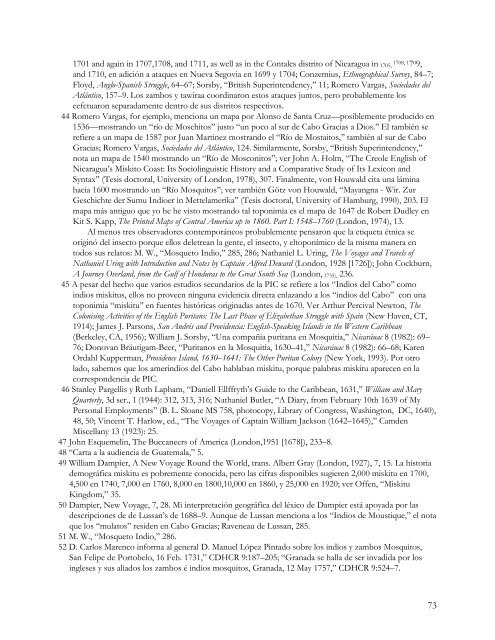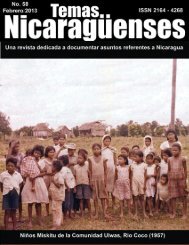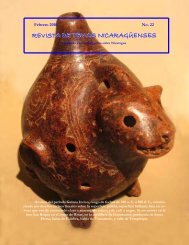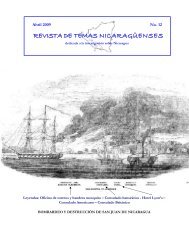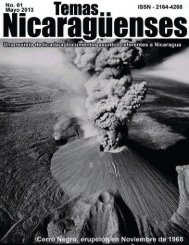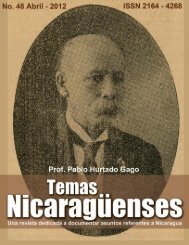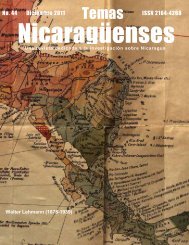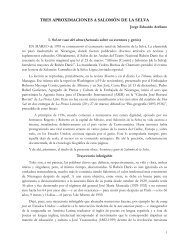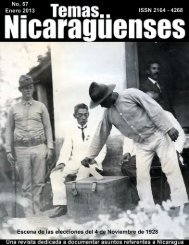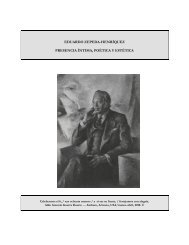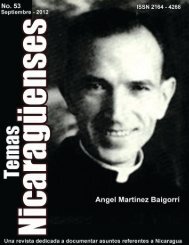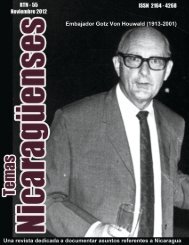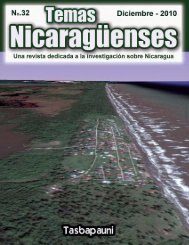21 - Revista de Temas Nicaragüenses
21 - Revista de Temas Nicaragüenses
21 - Revista de Temas Nicaragüenses
You also want an ePaper? Increase the reach of your titles
YUMPU automatically turns print PDFs into web optimized ePapers that Google loves.
1701 and again in 1707,1708, and 1711, as well as in the Contales distrito of Nicaragua in 1705, 1708, 17 09,<br />
and 1710, en adición a ataques en Nueva Segovia en 1699 y 1704; Conzemius, Ethnographical Survey, 84–7;<br />
Floyd, Anglo-Spanish Struggle, 64–67; Sorsby, “British Superinten<strong>de</strong>ncy,’’ 11; Romero Vargas, Socieda<strong>de</strong>s <strong>de</strong>l<br />
Atlántico, 157–9. Los zambos y tawiraa coordinaron estos ataques juntos, pero probablemente los<br />
eefctuaron separadamente <strong>de</strong>ntro <strong>de</strong> sus distritos respectivos.<br />
44 Romero Vargas, for ejemplo, menciona un mapa por Alonso <strong>de</strong> Santa Cruz—posiblemente producido en<br />
1536—mostrando un “río <strong>de</strong> Moschitos’’ justo “un poco al sur <strong>de</strong> Cabo Gracias a Dios.’’ El también se<br />
refiere a un mapa <strong>de</strong> 1587 por Juan Martinez mostrando el “Río <strong>de</strong> Mostaitos,’’ también al sur <strong>de</strong> Cabo<br />
Gracias; Romero Vargas, Socieda<strong>de</strong>s <strong>de</strong>l Atlántico, 124. Similarmente, Sorsby, “British Superinten<strong>de</strong>ncy,’’<br />
nota un mapa <strong>de</strong> 1540 mostrando un “Río <strong>de</strong> Mosconitos’’; ver John A. Holm, “The Creole English of<br />
Nicaragua’s Miskito Coast: Its Sociolinguistic History and a Comparative Study of Its Lexicon and<br />
Syntax’’ (Tesis doctoral, University of London, 1978), 307. Finalmente, von Houwald cita una lámina<br />
hacia 1600 mostrando un “Río Mosquitos’’; ver también Götz von Houwald, “Mayangna - Wir. Zur<br />
Geschichte <strong>de</strong>r Sumu Indioer in Mettelamerika’’ (Tesis doctoral, University of Hamburg, 1990), 203. El<br />
mapa más antiguo que yo he he visto mostrando tal toponimia es el mapa <strong>de</strong> 1647 <strong>de</strong> Robert Dudley en<br />
Kit S. Kapp, The Printed Maps of Central America up to 1860. Part I: 1548–1760 (London, 1974), 13.<br />
Al menos tres observadores contemporáneos probablemente pensaron que la etiqueta étnica se<br />
originó <strong>de</strong>l insecto porque ellos <strong>de</strong>letrean la gente, el insecto, y eltoponímico <strong>de</strong> la misma manera en<br />
todos sus relatos: M. W., “Mosqueto Indio,’’ 285, 286; Nathaniel L. Uring, The Voyages and Travels of<br />
Nathaniel Uring with Introduction and Notes by Captain Alfred Deward (London, 1928 [1726]); John Cockburn,<br />
A Journey Overland, from the Gulf of Honduras to the Great South Sea (London, 1735), 236.<br />
45 A pesar <strong>de</strong>l hecho que varios estudios secundarios <strong>de</strong> la PIC se refiere a los “Indios <strong>de</strong>l Cabo’’ como<br />
indios miskitus, ellos no proveen ninguna evi<strong>de</strong>ncia directa enlazando a los “indios <strong>de</strong>l Cabo” con una<br />
toponimia “miskitu’’ en fuentes históricas originadas antes <strong>de</strong> 1670. Ver Arthur Percival Newton, The<br />
Colonising Activities of the English Puritans: The Last Phase of Elizabethan Struggle with Spain (New Haven, CT,<br />
1914); James J. Parsons, San Andrés and Provi<strong>de</strong>ncia: English-Speaking Islands in the Western Caribbean<br />
(Berkeley, CA, 1956); William J. Sorsby, “Una compañia puritana en Mosquitia,’’ Nicaráuac 8 (1982): 69–<br />
76; Donovan Bräutigam-Beer, “Puritanos en la Mosquitia, 1630–41,’’ Nicaráuac 8 (1982): 66–68; Karen<br />
Ordahl Kupperman, Provi<strong>de</strong>nce Island, 1630–1641: The Other Puritan Colony (New York, 1993). Por otro<br />
lado, sabemos que los amerindios <strong>de</strong>l Cabo hablaban miskitu, porque palabras miskitu aparecen en la<br />
correspon<strong>de</strong>ncia <strong>de</strong> PIC.<br />
46 Stanley Pargellis y Ruth Lapham, “Daniell Ellffryth’s Gui<strong>de</strong> to the Caribbean, 1631,’’ William and Mary<br />
Quarterly, 3d ser., 1 (1944): 312, 313, 316; Nathaniel Butler, “A Diary, from February 10th 1639 of My<br />
Personal Employments’’ (B. L. Sloane MS 758, photocopy, Library of Congress, Washington, DC, 1640),<br />
48, 50; Vincent T. Harlow, ed., “The Voyages of Captain William Jackson (1642–1645),” Cam<strong>de</strong>n<br />
Miscellany 13 (1923): 25.<br />
47 John Esquemelin, The Buccaneers of America (London,1951 [1678]), 233–8.<br />
48 “Carta a la audiencia <strong>de</strong> Guatemala,” 5.<br />
49 William Dampier, A New Voyage Round the World, trans. Albert Gray (London, 1927), 7, 15. La historia<br />
<strong>de</strong>mográfica miskitu es pobremente conocida, pero las cifras disponibles sugieren 2,000 miskitu en 1700,<br />
4,500 en 1740, 7,000 en 1760, 8,000 en 1800,10,000 en 1860, y 25,000 en 1920; ver Offen, “Miskitu<br />
Kingdom,” 35.<br />
50 Dampier, New Voyage, 7, 28. Mi interpretación geográfica <strong>de</strong>l léxico <strong>de</strong> Dampier está apoyada por las<br />
<strong>de</strong>scripciones <strong>de</strong> <strong>de</strong> Lussan’s <strong>de</strong> 1688–9. Aunque <strong>de</strong> Lussan menciona a los “Indios <strong>de</strong> Moustique,” el nota<br />
que los “mulatos” resi<strong>de</strong>n en Cabo Gracias; Raveneau <strong>de</strong> Lussan, 285.<br />
51 M. W., “Mosqueto Indio,” 286.<br />
52 D. Carlos Marenco informa al general D. Manuel López Pintado sobre los indios y zambos Mosquitos,<br />
San Felipe <strong>de</strong> Portobelo, 16 Feb. 1731,” CDHCR 9:187–205; “Granada se halla <strong>de</strong> ser invadida por los<br />
ingleses y sus aliados los zambos é indios mosquitos, Granada, 12 May 1757,” CDHCR 9:524–7.<br />
73


